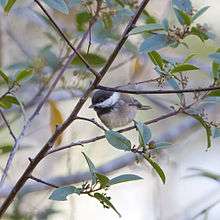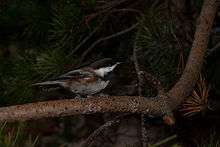Chestnut-backed chickadee
| Chestnut-backed chickadee | |
|---|---|
| | |
| Chestnut-backed chickadee by Louis Agassiz Fuertes | |
| Scientific classification | |
| Kingdom: | Animalia |
| Phylum: | Chordata |
| Class: | Aves |
| Order: | Passeriformes |
| Family: | Paridae |
| Genus: | Poecile |
| Species: | P. rufescens |
| Binomial name | |
| Poecile rufescens (Townsend 1837) | |
| Synonyms | |
|
Parus rufescens | |
The chestnut-backed chickadee (Poecile rufescens, formerly Parus rufescens) is a small passerine bird in the tit family, Paridae.
It is found in the Pacific Northwest of the United States and western Canada, from southern Alaska to southwestern California. It is a permanent resident within its range, with some seasonal movements as feeding flocks move short distances in search of food. They usually move to lower elevations in the same area upon onset of winter and move back up to higher elevations in late summer.
It is a small chickadee, 11.5–12.5 cm (4.5–4.9 in) long with a weight of 8.5–12.6 g (0.30–0.44 oz). The head is dark blackish-brown with white cheeks, the mantle is bright rufous-brown, the wing feathers are dark gray with paler fringes. The underparts are white to pale grayish-white, with rufous or pale gray flanks. It is often considered the most handsome of all chickadees.[2] They often move through the forest in mixed feeding flocks, and are often seen in large groups with bushtits and warblers.
There are three subspecies, with the flanks being grayer and less rufous further south (del Hoyo et al. 2007):
- Poecile rufescens rufescens (Townsend, 1837). Alaska south to northwest California. Broad rufous band on flanks.
- Poecile rufescens neglectus (Ridgway, 1879). Coastal central California (Marin County). Narrow rufous band on flanks.
- Poecile rufescens barlowi (Grinnell, 1900). Coastal southwestern California (south of San Francisco Bay). Almost no rufous color on flanks.

Its habitat is low elevation coniferous and mixed coniferous forests. In the San Francisco Bay Area this bird has readily adapted to suburban settings, prompting a range expansion. It is a cavity-nester, usually utilizing an abandoned woodpecker hole, but sometimes excavating on its own. Chestnut-backed chickadees use lots of fur and hair to make their nests. Their nests are actually 50% fur and hair. The most common hair they use comes from deer, rabbits, and coyotes. The adult chickadees also make a layer of fur about a centimeter thick which is used to cover the eggs on the nest whenever they leave the nest. It lays 5–8 (sometimes 9) eggs per clutch.
Its food is largely insects and other invertebrates gleaned from foliage. Chestnut-backed chickadees take some seeds, especially those of conifers, and fruit. It will visit bird feeders, including hummingbird feeders, and especially loves suet.
Often, it is still placed in the genus Parus with most other tits, but mtDNA cytochrome b sequence data and morphology suggest that separating Poecile more adequately expresses these birds' relationships (Gill et al., 2005). The American Ornithologists' Union has been treating Poecile as a distinct genus for some time already.

References
- ↑ BirdLife International (2012). "Parus rufescens". IUCN Red List of Threatened Species. Version 2013.2. International Union for Conservation of Nature. Retrieved 26 November 2013.
- ↑ BIRDS OF SONOMA COUNTY Archived June 14, 2011, at the Wayback Machine.
- del Hoyo, J., Elliot, A., & Christie D. (eds). (2007). Handbook of the Birds of the World. Volume 12: Picathartes to Tits and Chickadees. Lynx Edicions. ISBN 978-84-96553-42-2
- Gill, F. B., Slikas, B., & Sheldon, F. H. (2005). Phylogeny of titmice (Paridae): II. Species relationships based on sequences of the mitochondrial cytochrome-b gene. Auk 122: 121-143. DOI: 10.1642/0004-8038(2005)122[0121:POTPIS]2.0.CO;2 HTML abstract
- Miller, K. (2001). Animal Diversity Web: Parus rufescens. Retrieved 2006-NOV-21.
External links
| Wikimedia Commons has media related to Poecile rufescens. |
| Wikispecies has information related to: Poecile rufescens |
- Chestnut-backed chickadee at BirdHouses101.com
- Chestnut-backed chickadee species account – Cornell Lab of Ornithology
- Tool use by chestnut-backed chickadee
- "Chestnut-backed chickadee media". Internet Bird Collection.
- Chestnut-backed chickadee photo gallery at VIREO (Drexel University)
- Interactive range map of Poecile rufescens at IUCN Red List maps
